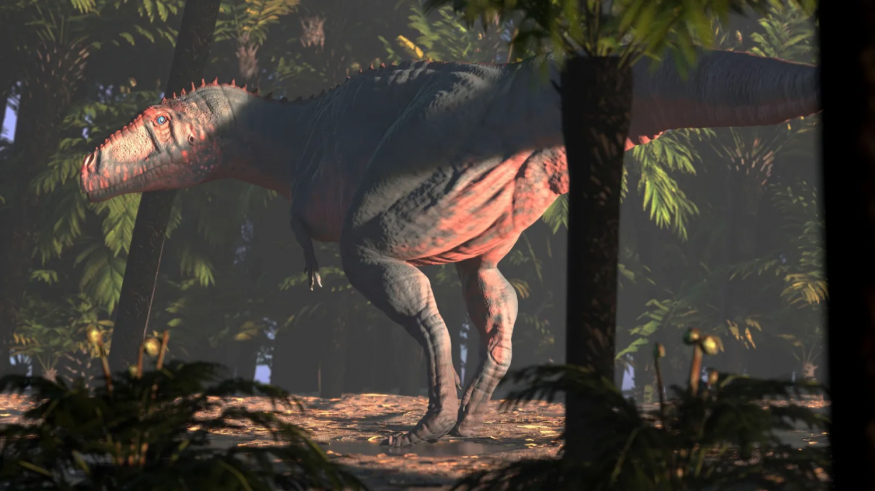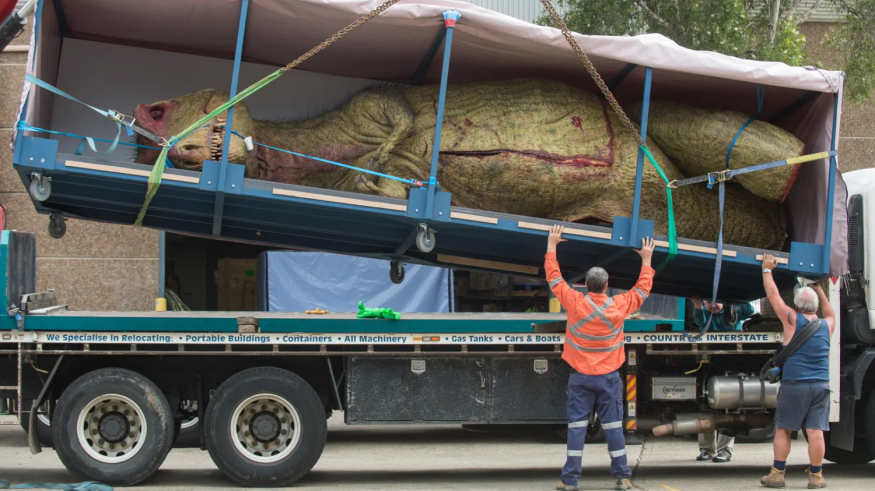In 1902, a team of paleontologists led by Barnum Brown searched for fossils in the Badlands of Montana. It was the end of the season, and they needed to find something valuable to send back to the American Museum of Natural History in New York. The team worked in hot, dusty conditions, chipping away at the earth with pickaxes and chisels. Despite their efforts, they often found only mediocre fossils.
Meanwhile, the museum's director, Henry Fairfield Osborn, eagerly awaited their findings. However, when the team sent him a large rock containing the skull of a duck-billed dinosaur, he was disappointed to find that the fossil was damaged and unusable. Osborn felt the specimen, transported over 2,100 miles with great care, was a waste.
After facing challenges and setbacks, the team finally succeeded when Barnum Brown discovered several bones from a large carnivorous dinosaur previously unknown to science. The bones, including a hip bone 5 feet long, belonged to the first ever discovered Tyrannosaurus rex. Brown recognized the significance of the find and informed his boss, Henry Fairfield Osborn, in a letter. The discovery of T. rex would significantly impact the study of dinosaurs and generate widespread public interest in this group of ancient animals for many years to come.
From the very first discovery of T. rex, the small size of its arms has been a mystery. The T. rex skeleton discovered by Barnum Brown was missing its fingers and forearms, which were depicted in early portraits based on assumptions about their appearance. These small arms have raised questions about their purpose and how they became so small.

Solving the Arm Mystery
T. rex is well known for its small arms, which seem disproportionately small compared to its enormous teeth. These arms, which may have been only about 3 feet long on a 45-foot individual, have puzzled scientists and been the subject of much speculation since their discovery. Despite many years of study, the purpose of T. rex's small arms remains a mystery. Some have even suggested that the arms may have been added to the T. rex skeleton from another species, similar to how the back plates of a Stegosaurus were once attached to its tail.
L J Krumenacker, a paleontologist at Idaho State University, notes that the small size of T. rex's arms seems unusual and raises questions about their purpose. The first T. rex skeleton discovered by Barnum Brown in 1902 included a limited number of bones, including a pelvis, a shoulder blade, an upper arm bone, and part of the skull. However, it was missing its arms. Six years later, Brown discovered another T. rex specimen in Colorado that was relatively complete but also missing its arms.
For much of the 20th century, scientists had to make educated guesses about what T. rex's arms might have looked like, often using the arms of the closely related tyrannosaur Gorgosaurus as a reference. It wasn't until 1988 that a T. rex specimen with arms was discovered by accident when rancher Kathy Wankel found a strange protrusion near Fort Peck Lake in Montana.
'Wankel Rex'
After discovering the strange protrusion, Wankel returned a month later to dig out a set of long bones and took them to the Museum of the Rockies. The director of paleontology there recognized that they were T. rex arm bones, and eventually, the rest of the dinosaur was excavated. The resulting specimen, known as the "Wankel Rex," was extremely well preserved and weighed about 7,000 pounds. Its forelimbs were smaller than previously thought.
Since the discovery of T. rex, scientists have learned much about various aspects of the dinosaur's life, including its walking gait and its vulnerability to gout. However, despite much research, the purpose of T. rex's small arms remains unknown. Some scientists have even found preserved collagen in exceptional fossils, which may provide further insights into T. rex anatomy and behavior. However, the mystery of the small arms persists.
One early suggestion for T. rex's small arms came from Henry Fairfield Osborn, who named the dinosaur. Osborn compared the arms to the small fins, called claspers, that male sharks use to hold onto females during mating. Scott Persons, head curator of the Mace Brown Museum of Natural History in South Carolina, explains that Osborn "envisioned a pair of tyrannosaurs entwined in primordial courtship with the male on top and using those arms to grip a hold on the female." However, this theory has not been widely accepted by the scientific community.
Scott Persons, head curator of the Mace Brown Museum of Natural History in South Carolina, suggests that T. rex's small arms may have been used for mating, although this theory has not been widely accepted. Another possibility is that the arms may have been used to help T. rex get up off the ground, although the arms would not have been strong enough to lift the entire body. A single scientist proposed in 2017 that T. rex's arms may have been used as weapons, but this idea has been met with skepticism.

Unnecessary Long Arms
It is also possible that T. rex's small arms had no function and were vestigial structures that were no longer necessary for the dinosaur's survival. In this scenario, T. rex may have eventually evolved to lose its arms, resembling a land shark. Scott Persons believes that if T. rex had not become extinct, its arms might have continued to shrink over time and potentially been lost completely.
He notes that even if T. rex's arms did not serve a major function, they might have been preserved for a small purpose, such as nest digging or grooming. He suggests that T. rex may have had feathers and that the small arms may have been used for grooming them. However, these ideas are purely speculative, and there is no evidence to support them.
Some scientists have proposed that T. rex may have been more social than previously, based on discovering multiple T. rex fossils at three different sites in North America. It has been suggested that T. rex may have eaten in packs like hyenas, which could have made it useful to have small arms that didn't get in the way during feeding frenzies.
However, this idea is difficult to test, and there are no living animals with a similar body plan to T. rex that could serve as an analogy. The closest comparison might be ground-dwelling predatory birds. It has been suggested that T. rex's small arms may have evolved to allow for the development of a large head and powerful bite. Researchers have found that another dinosaur, Meraxes gigas, which lived in Patagonia during the Late Cretaceous period, had a similar body plan to T. rex with a large body and oversized head but undersized arms. It is thought that as the head and bodies of these predators grew larger, their arms became correspondingly smaller to help them balance.

Small Arms For Powerful Bite
T. rex's teeth were serrated and designed for crushing bone rather than piercing or slicing flesh. The small arms may have allowed for the development of the powerful bite needed to crush bones and tear off chunks of flesh from their prey. T. rex's powerful bite required strong jaws and a lot of muscle to operate effectively. This led to the development of a large head and neck, which could be a problem for a two-legged animal like T. rex.
Larger arms would have caused the front end of the dinosaur to tip forward, while a larger tail would have been needed to counterbalance the head's weight. To avoid these issues, T. rex evolved smaller arms, which may have helped it maintain its balance while still being able to deliver powerful bites with its large, serrated teeth. It is possible that the true function of T. rex's small arms may never be fully understood, as the context needed to understand their purpose may have been lost to the fossil record over the 66 million years since T. rex lived.
It has been suggested that human beings may be particularly interested in the function of T. rex's arms because they place a lot of importance on their arms and hands, which are critical to their survival. As humans rely heavily on their arms and hands to interact with their environment, it is difficult for us to imagine willingly giving them up. T. rex's small arms may seem strange to us because they appear to have little use compared to the importance of our arms and hands. Despite this, T. rex was a highly successful and intimidating animal, suggesting that its small arms did not hinder its survival.
RELATED ARTICLE: Why Did T. Rex Have Small Arms? Shorter Forelimbs May Have Saved Them During Feeding Frenzies, Study Claims
Check out more news and information on Paleontology in Science Times.
© 2025 ScienceTimes.com All rights reserved. Do not reproduce without permission. The window to the world of Science Times.










